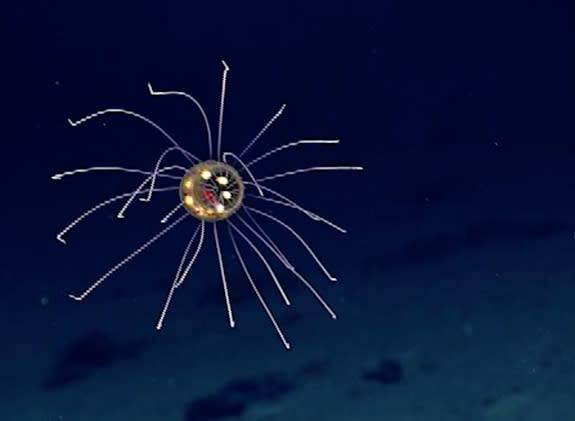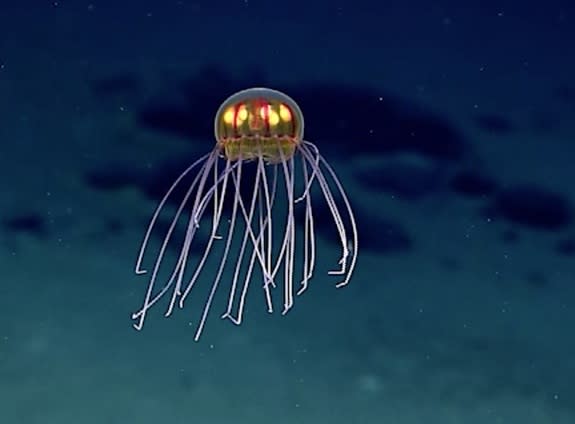Jellyfish from Outer Space? Amazing Glowing Creature Spotted
With red and yellow lights seeming to glow inside its bulbous body, a newfound jellyfish looks more alien spaceship than deep-sea cnidarian.
Using a remotely operated vehicle (ROV), marine scientists dove to the deepest part of the world's oceans, called the Mariana Trench, east of the Mariana Islands near Guam in the western Pacific Ocean; they were exploring the so-called Enigma Seamount (named for the lack of information scientists have on it) when they came upon this surreal-looking creature.
Video captured of the jellyfish reveals a stunning sight: The organism sports two sets of tentacles, long and short, that extend from its pulsating bell. When the long tentacles are extended outward, the jellyfish's bell remains still. That feature, the researchers noted in a statement by the National Oceanic and Atmospheric Administration (NOAA), suggests the jellyfish is an ambush predator. [Video: Watch the Alien Jellyfish in Action]
Inside the bell, which resembles a flying saucer of sorts, are red canals that seem to connect bright-yellow gonads, according to the scientists. From the looks of the jellyfish, the researchers identified it as belonging to the genus Crossota.
Scientists operating the ROV Deep Discoverer from aboard the research vessel Okeanos Explorer found the jellyfish on April 24 at a depth of 12,140 feet (3,700 meters). This was the fourth dive for the ROV for the first leg of a mission called the 2016 Deepwater Exploration of the Marianas, a three-cruise expedition run by NOAA and partners with the goal of understanding the deep-water habitats in and around the Mariana Trench. During the dive, the scientists found other fascinating features of this underwater mountain they call Enigma Seamount.
"Its morphology is quite different from other seamounts in the region, which generally have a flat top with steep, smooth sides radiating out into narrow ridges," they wrote in a daily log of the expedition. "By contrast, this one is more circular in form and the sides are much less smooth."
Throughout the ROV dive, the researchers also noticed "small, rounded balls that looked like they had been constructed from sediment," they wrote. The balls could be a large species of single-celled amoeba or they could be marine sponges, the researchers said. Though deep-sea animals were scarce, the researchers said they did observe some wacky creatures, including "stalked crinoids and primnoid corals, swimming polychaete worms, a cusk eel, Caulophacus sponges, cladhorizid sponges, a Munidopsis squat lobster, a beautiful hydrozoan jellyfish and at least two Nematocarcinus shrimp."
This leg of the expedition is scheduled to end May 11, with the second leg slated for a May 20 departure, with the third leg set to begin June 17.
Follow us @livescience, Facebook & Google+. Original article on Live Science.
Copyright 2016 LiveScience, a Purch company. All rights reserved. This material may not be published, broadcast, rewritten or redistributed.



